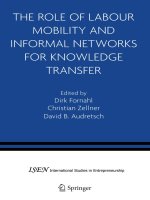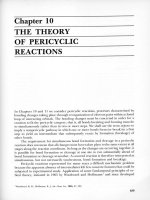HRM 5th chapter 14 the dynamics of labour relations
Bạn đang xem bản rút gọn của tài liệu. Xem và tải ngay bản đầy đủ của tài liệu tại đây (644.1 KB, 36 trang )
The Dynamics of
Labour Relations
Managing Human Resources
Belcourt * Bohlander * Snell
5th Canadian edition
PowerPoint Presentation by
Copyright © 2008 by Nelson, a division of Thomson
Canada Limited.
All rights reserved.
Monica Belcourt, York University and
Charlie Cook, The University of West Alabama
Objectives
After studying this chapter, you should be able to:
1.
Identify and explain the federal and provincial
legislation that provide the framework for labour
relations.
2.
Explain the reasons employees join unions.
3.
Describe the process by which unions organize
employees and gain recognition as their bargaining
agent.
4.
Discuss the bargaining process and the bargaining
goals and strategies of a union and an employer.
Copyright © 2008 by Nelson, a
14–2
Objectives
(cont’d)
After studying this chapter, you should be able to:
5. Differentiate the forms of bargaining power
that a union and an employer may utilize to
enforce their bargaining demands.
6. Describe a typical union grievance procedure
and explain the basis for arbitration awards.
Copyright © 2008 by Nelson, a
14–3
Government Regulation of Labour Relations
• The Industrial Relations Disputes and Investigation Act
• Canada Labour Code
Copyright © 2008 by Nelson, a
14–4
Labour Relations Board
• Administrating the statutory procedures for the acquisition,
transfer and termination of bargaining rights
• Hearing complaints related to unfair labour practices
• Supervising strikes and lock out votes
• Determining whether bargaining was done in good faith
• Remedying violations of collective bargaining legislation.
Copyright © 2008 by Nelson, a
14–5
Labor Relations Process
1.
Workers desire collective representation.
2.
Union begins its organizing campaign.
3.
Collective negotiations lead to a contract.
4.
The contract is administered.
Copyright © 2008 by Nelson, a
14–6
Why Employees Unionize
• As a result of economic needs (wages and benefits).
• Dissatisfaction with managerial practices.
• To fulfill social and status needs.
• Unionism is viewed as a way to achieve results they cannot
achieve acting individually.
• To comply with union-shop provisions of the collective
agreement in effect where they work.
Copyright © 2008 by Nelson, a
14–7
The Labour Relations Process
Figure 14.1
Copyright © 2008 by Nelson, a
14–8
Organizing
Campaigns
Steps
Stepsin
inthe
the
Organizing
Organizing
Process
Process
Union/Employee
Union/EmployeeContact
Contact
Initial
Initial Organizational
Organizational
Meeting
Meeting
Formation
Formationof
of In-House
In-House
Committee
Committee
Application
Applicationto
tolabour
labour
relations
relationsboard
boardand
and
issuance
issuanceof
ofcertificate
certificate
Election
Election of
ofbargaining
bargaining
committee
committeeand
and contract
contract
negotiations
negotiations
Copyright © 2008 by Nelson, a
14–9
United Food and Commercial Workers
International Union Authorization Card
Copyright © 2008 by Nelson, a
14–10
Employer Tactics Opposing Unionization
• Stressing favourable employer-employee relationship
experienced without a union.
• Emphasize current advantages in wages, benefits, or working
conditions the employees may enjoy.
• Emphasize unfavourable aspects of unionism: strikes, union
dues.
• Initiate legal action when union members and leaders engage
in unfair labour practices.
Copyright © 2008 by Nelson, a
14–11
Employer “Don’ts”
Duringduring
Union Organizing
Campaigns Campaigns
Employer
“Don’ts”
Union Organizing
• Attending union meetings, spying on employee-union gatherings, or
questioning employees about the content of union meetings.
• Questioning present or current employees about their union
sentiments, particularly about how they might vote in a union election.
• Threatening or terminating employees for their union support or
beliefs.
• Changing the working conditions of employees because they actively
work for the union or simply support its ideals.
• Supplying the names, addresses, and phone numbers of employees to
union representatives or other employees sympathetic to the union.
• Promising employees improvements in working conditions (wage
increases, benefit improvements, and so on) if they vote against the
union.
• Accepting or reviewing union authorization cards or pro-union
petitions, because employees’ names are listed on these documents.
Figure 14.2
Copyright © 2008 by Nelson, a
14–12
Unfair Labour Practices for Unions
• Unions are prohibited from interfering with the formation of an
employer’s organization.
• Unions cannot intimidate or coerce employees to become or
remain members of a union.
• Unions cannot force employers to dismiss, discipline or
discriminate against non-union employees.
• Unions must provide fair representation for all employees in
the bargaining unit.
Copyright © 2008 by Nelson, a
14–13
How Employees Become Unionized
• Voluntary recognition
• Regular certification
• Prehearing votes
Copyright © 2008 by Nelson, a
14–14
Contract Negotiation
• Once the bargaining
unit has been certified
by the labour relations
board, the employer and
the union must bargain
in good faith over the
terms and conditions of
a collective agreement.
Copyright © 2008 by Nelson, a
14–15
Decertification
• If the majority of employees indicate that they do not want to
be represented by the union
or
• They want to be represented by another union or
• If the union failed to bargain
Copyright © 2008 by Nelson, a
14–16
Impact of Unionization on Managers
• Challenges to Management Prerogatives
Management prerogatives versus union participation
in decision-making in the work place.
• Loss of Supervisory Authority
Constraints on management in directing and
disciplining the work force by terms of the collective
bargaining agreement.
Copyright © 2008 by Nelson, a
14–17
Structures, Functions, and Leadership of
Labour Unions
• Craft unions
Unions that represent skilled craft workers
• Industrial unions
Unions that represent all workers—skilled,
semiskilled, unskilled—employed along industry lines
• Employee associations
Labour organizations that represent various groups of
professional and white-collar employees in labourmanagement relations.
Copyright © 2008 by Nelson, a
14–18
Types of Unions
• The Canadian Labour Congress
• International and National unions
• Local unions
Copyright © 2008 by Nelson, a
14–19
Typical Organization of a Local Union
Local
LocalUnion
UnionMeeting
Meeting (Normally
(NormallyMonthly)
Monthly)
Business
Business
Representative
Representative
President
President
Secretary/Treasurer
Secretary/Treasurer
Vice-Presidents
Vice-Presidents
Sergeant
SergeantatatArms
Arms
Various
VariousCommittee
CommitteeChairpersons
Chairpersons
Training
Trainingand
and
Education
Education
Grievance
Grievance
Committee:
Committee:
Chief
ChiefSteward
Stewardand
and
Shop
Stewards
Shop Stewards
Collective
Collective
Bargaining
Bargaining
Social
Social
Local
LocalUnion
UnionMembers
Members
Copyright © 2008 by Nelson, a
14–20
Structure and Functions of Local Unions
• Local Officers
Elected officials who lead the union and serve on the
bargaining committee for a new contract.
• Union Steward
An employee, as a nonpaid union official, represents
the interests of members in their relations with
management.
• Business Unionism
The term applied to the goals of labour organizations,
which collectively bargain wages, hours, job security,
and working conditions.
Copyright © 2008 by Nelson, a
14–21
Labour Relations in the Public Sector
• Political nature of the labour management relationship
Alternate services are not available
Source of management authority
Strikes in public sector- essential services
Copyright © 2008 by Nelson, a
14–22
Types of Arbitration
• Compulsory Binding Arbitration
A process for employees such as police officers,
firefighters, and others in jobs where strikes cannot
be tolerated to reach agreement.
• Final-offer Arbitration
The arbitrator must select one or the other of the final
offers submitted by the disputing parties with the
award is likely to go to the party whose final
bargaining offer has moved the closest toward a
reasonable settlement.
Copyright © 2008 by Nelson, a
14–23
The Collective Bargaining Process
Figure 14.4
Copyright © 2008 by Nelson, a
14–24
The Bargaining Process
• Collective Bargaining Process
The process of negotiating a collective agreement,
including the use of economic pressures by both
parties.
• Bargaining Zone
Area within which the union and the employer are
willing to concede when bargaining.
• Interest-based Bargaining
Problem-solving bargaining based on a win-win
philosophy and the development of a positive longterm relationship.
Copyright © 2008 by Nelson, a
14–25









